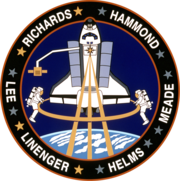STS-64

Astronauts Lee and Meade perform an EVA in Discovery's payload bay
|
|||||
| Mission type | Research Technology |
||||
|---|---|---|---|---|---|
| Operator | NASA | ||||
| COSPAR ID | 1994-059A | ||||
| SATCAT № | 23251 | ||||
| Mission duration | 10 days, 22 hours, 49 minutes, 57 seconds | ||||
| Distance travelled | 7,242,048 kilometers (4,500,000 mi) | ||||
| Orbits completed | 176 | ||||
| Spacecraft properties | |||||
| Spacecraft | Space Shuttle Discovery | ||||
| Payload mass | 9,260 kilograms (20,410 lb) | ||||
| Crew | |||||
| Crew size | 6 | ||||
| Members |
Richard N. Richards L. Blaine Hammond, Jr. Jerry M. Linenger Susan J. Helms Carl J. Meade Mark C. Lee |
||||
| Start of mission | |||||
| Launch date | 9 September 1994, 22:22:35 UTC | ||||
| Launch site | Kennedy LC-39B | ||||
| End of mission | |||||
| Landing date | 20 September 1994, 21:12:52 UTC | ||||
| Landing site | Edwards Runway 4 | ||||
| Orbital parameters | |||||
| Reference system | Geocentric | ||||
| Regime | Low Earth | ||||
| Perigee | 259 kilometres (161 mi) | ||||
| Apogee | 269 kilometres (167 mi) | ||||
| Inclination | 56.9 degrees | ||||
| Period | 89.5 min | ||||
|
|
|||||


Left to right - Front: Hammond, Richards, Helms; Back: Lee, Linenger, Meade
STS-64 was a Space Shuttle Discovery mission to perform multiple experiment packages. It was launched from Kennedy Space Center, Florida, on 9 September 1994.
STS-64 marked the first flight of Lidar In-space Technology Experiment (LITE) and the first untethered U.S. extravehicular activity (EVA) in 10 years. LITE payload employs lidar, which stands for light detection and ranging, a type of optical radar using laser pulses instead of radio waves to study Earth's atmosphere. The first spaceflight of lidar was a highly successful technology test. The LITE instrument operated for 53 hours, yielding more than 43 hours of high-rate data. Unprecedented views were obtained of cloud structures, storm systems, dust clouds, pollutants, forest burning and surface reflectance. Sites studied included atmosphere above northern Europe, Indonesia and the south Pacific, Russia and Africa. Sixty-five groups from 20 countries made validation measurements with ground-based and aircraft instruments to verify LITE data. The LITE science program wad part of NASA's Mission to Planet Earth.
Mission Specialists Lee and Meade completed the 28th EVA of the Space Shuttle program on 16 Sept. During the six-hour, 15- minute EVA, they tested a new backpack called Simplified Aid for EVA Rescue (SAFER), designed for use in event crew member becomes untethered while conducting an EVA. Operations with SAFER marked the first untethered EVA since STS 51-A in 1984, and also the last such EVA of the program. SAFER went on to become a mainstay of US and joint spacewalks during the assembly of the International Space Station and beyond.
...
Wikipedia
